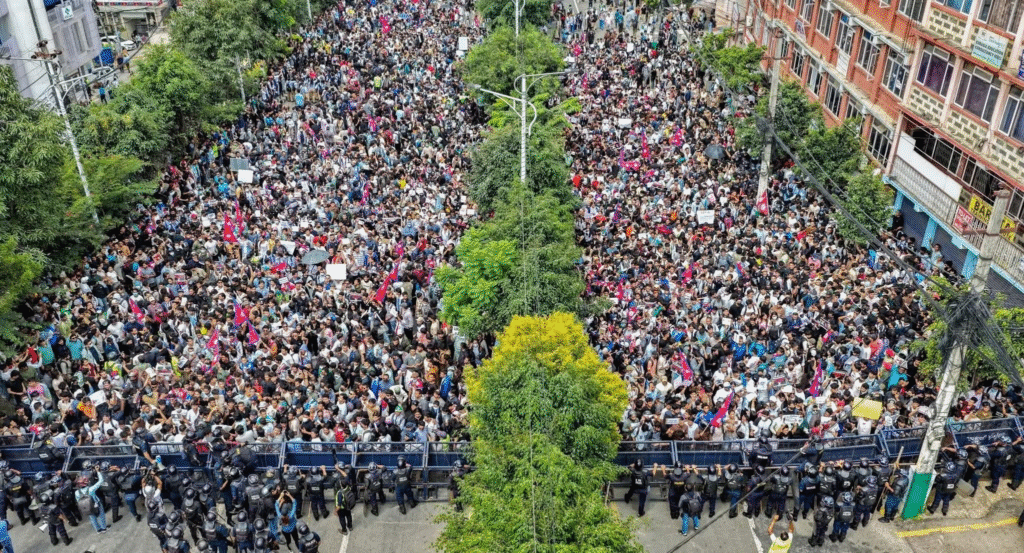Nepal Protests LIVE: Nepal is on edge after a wave of violent protests left at least 19 people dead and more than 250 injured across the country. The unrest, led primarily by Gen Z demonstrators, erupted in response to the government’s sudden ban on several social media platforms, including Facebook, Instagram, and WhatsApp.

The protests, which began peacefully in Kathmandu, quickly spiraled out of control as police fired tear gas, rubber bullets, and, according to witnesses, even live rounds to disperse crowds. The country’s Home Minister Ramesh Lekhak resigned late Monday, taking moral responsibility for the bloodshed.
Security has been tightened not only in Nepal but also across bordering districts of Uttar Pradesh in India, where panic is spreading among families who rely on social media to connect with relatives across the border.
Why Are Nepal’s Gen Z Protesting?
The spark for the protests was the government’s decision to ban 26 unregistered social media platforms. Authorities argued the move was necessary to curb fake accounts, hate speech, and online fraud.
But for young Nepalis, the ban feels like an attack on freedom of expression and their digital lifeline.

Voices from the ground
“We were triggered by the ban, but corruption is the bigger issue,” said Yujan Rajbhandari, a 24-year-old student.
- Protesters carried placards with messages like “Shut down corruption, not social media” and “Unban social media.”
For many, social media is more than entertainment—it is a tool for activism, education, and cross-border family ties.
The Bloodiest Day in Two Decades
The violence of September 8 has been described as Nepal’s deadliest day of protest in 20 years.
- 17 deaths were reported in Kathmandu alone.
- Two deaths occurred in Itahari City, Sunsari district.
- Among the victims was a 12-year-old child, highlighting the scale of the tragedy.
Doctors at Kathmandu hospitals confirmed that many victims were shot in the head and chest. Families lined up outside trauma centers, anxiously waiting for updates, while citizens rushed to donate blood.
Government Response: Firm or Failing?
Prime Minister K.P. Sharma Oli defended the crackdown, insisting his government supports social media but cannot tolerate lawlessness.
“We oppose arrogance and anomalies. Businesses operating in Nepal must comply with our laws,” Oli said.
However, critics accuse the government of using the ban to silence dissent while turning a blind eye to institutional corruption.
The National Human Rights Commission (NHRC) has demanded fair compensation for victims’ families and a full investigation.
UN and Global Reaction
The United Nations Human Rights Office condemned the violence, calling for a swift, transparent probe into allegations of disproportionate force.
UN spokesperson Ravina Shamdasani said:
“We are shocked by the killings and urge authorities to respect freedom of expression and peaceful protest.”
Amnesty International also expressed concern, saying protesters reported being fired on with live ammunition.
Tensions Spill Over to India
Nepal’s unrest has immediate implications for India, particularly Uttar Pradesh, which shares a porous border with the Himalayan nation.
Residents in Maharajganj and Bahraich districts said they are struggling without social media. Many families, especially those with daughters married in Nepal, relied on WhatsApp and Facebook to stay connected.
Authorities in UP have:
- Deployed additional police forces along the border.
- Started drone monitoring.
- Put the Sashastra Seema Bal (SSB) on high alert.
What Happens Next?
Nepal’s political stability hangs by a thread. With youth leading the charge, the government faces an unprecedented challenge: balance law and order while addressing deep-rooted anger over corruption and restrictions on free speech.
Whether the ban will be lifted remains unclear. Officials say platforms will be restored once they register and comply with local laws, but protesters argue the damage is already done.
FAQs on Nepal Protest Crisis
Q1: Why did Nepal ban social media platforms?
How many people have died so far?
Why did the Home Minister resign?
Is the situation under control now?
How is India responding?
The Nepal protests highlight not just a generational battle over digital freedom but also a broader cry against corruption and governance failures. For Gen Z, the fight isn’t just about Facebook—it’s about their future.
